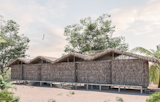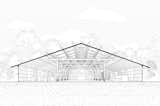Credits
From MWARQ
An hour by boat from Manaus and on the left bank of the Rio Negro, the Indigenous Community of Cipiá is home to six ethnic groups and six different languages. The tribe is made up of fifty people, fifteen families, who today live exclusively from tourism and the sale of handicrafts. Already having a small structure to receive tourists, they sought to expand their infrastructure to bring more income to the community.
Through the structured initiative named Amazone-se Cipiá, a project by the non-profit organization Base Collaborative, studio MEMM, Marcela Wandenkolk Arquitetura e Interiores and Studio ZZ got together with the CIPIÁ Indigenous Community to start the development of two new projects: the Cultural Nucleus and the Hostel in the CIPIÁ Indigenous Community.
As a result of many dialogues with local leaders, the architects arrived at the new concept of sustainable architecture for the space, which will bring together indigenous people, tourists and researchers to exchange experiences, rescue the community's history and celebrate the Desana culture.
The use of local raw materials and labor, in addition to care in providing thermal comfort and natural lighting, guided the entire project. The implantation was discussed with the community, reaching a proposal that would not cause an impact on the native vegetation. During conversations with the community, in addition to the desire for a structure to generate income, the architects realized that there were other basic needs that were not met, such as the lack of a structured solution for water collection and waste management. From that moment on, the project was divided into three pillars: Living Culture, Income and Water.
The first project was developed for a space called by community members “Casa do Saber”. Responding to the chief's requests, an architecture was proposed that mirrors the largest existing construction in the tribe. The openings in the roof were thought to work manually, by activating ropes that adjust their inclination, thus controlling the light and wind that pass through there and making the project adaptable to the most diverse conditions. This building has the purpose of maintaining the interest of younger people, who attend schools with the national standard teaching curriculum, for the original culture of the community. The House will also have a library, museum of artifacts and environments so that anthropologists can absorb and document the Cipiá culture.
The accommodation modules are self-sufficient and were implemented in such a way that they do not mix with the community's housing, closer to the banks and the structure to receive tourists. They are modules that can be easily replicated by the community, elevated from the ground. Ways of treating waste generated by visitors were also discussed with the community and proposed in the project.
The use of local raw materials and labor, in addition to care in providing thermal comfort and natural lighting, guided the entire project. The implantation was discussed with the community, reaching a proposal that would not cause an impact on the native vegetation. During conversations with the community, in addition to the desire for a structure to generate income, the architects realized that there were other basic needs that were not met, such as the lack of a structured solution for water collection and waste management. From that moment on, the project was divided into three pillars: Living Culture, Income and Water.
The biggest challenge, however, is finding solutions with the lowest possible impact to solve the community's water supply and sewage treatment problems, taking into account the limitations of the existing infrastructure. The team, at this moment, seeks the collaboration of professionals from other areas to align proposals.
The close relationship with the local population was essential for the development of the project, which was approved at the end of 2020. The initiative is now in the fundraising phase to carry out the works. To learn more, visit the project's Instagram @amazone.se.
INFO:
Location: Manaus, Amazona, Brazil.
Area: Aprox. 40m²
Status: Ongoing Project.





